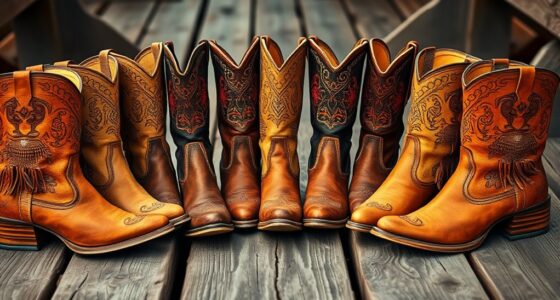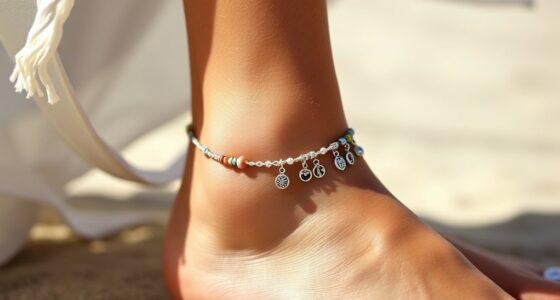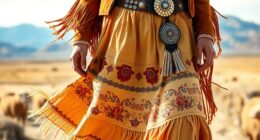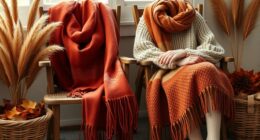I have compiled a list of 15 essential books that delve into various aspects of sustainable fashion. These titles shed light on ethical labor practices, innovative materials, and responsible consumption. For example, “Sustainable Fashion and Textiles” explores design processes, while “Minimalista” provides practical tips for creating an eco-friendly wardrobe. Each book offers valuable insights into the lifecycle of clothing, empowering you to make well-informed decisions. These resources cater to a range of interests and expertise levels, ensuring accessibility for all. If you are eager to enhance your understanding of sustainable fashion, you will discover a wealth of valuable information in the recommended books.
Key Takeaways
- Explore influential titles that cover ethical labor practices and innovative materials in sustainable fashion to enhance your understanding of eco-friendly practices.
- Discover books focusing on successful sustainable brands, showcasing their approaches to organic fabrics and ethical production to inspire your wardrobe choices.
- Learn about actionable strategies for creating a sustainable wardrobe, including garment care and upcycling, through insightful literature.
- Find resources that highlight the environmental impacts of fashion, helping you make informed decisions as a conscious consumer.
Sustainable Fashion and Textiles: Design Journeys

For anyone enthusiastic to dive deep into the world of sustainable fashion, 'Sustainable Fashion and Textiles: Design Journeys' stands out as an important resource that blends extensive research with practical insights.
This updated second edition thoroughly defines the field, structured into two main sections.
The first four chapters guide readers through the lifecycle stages of textiles, from material cultivation to disposal.
The latter chapters explore innovative design approaches that encourage sustainable consumption.
I found the content both informative and accessible, making it suitable for academic study or casual reading.
The book emphasizes an ethical framework for sustainability, challenging the idea that fashion is merely driven by trends.
Overall, it's a crucial read for anyone committed to understanding sustainable fashion better.
Best For: Individuals, professionals, and students interested in deepening their understanding of sustainable practices in the fashion and textiles industry.
Pros:
- Provides comprehensive insights into the lifecycle of textiles and sustainable design approaches.
- Well-written and accessible, making it suitable for both academic and casual readers.
Cons:
- May require prior knowledge of sustainability concepts for full comprehension.
- Some readers might find the depth of content overwhelming.
Sustainable Fashion: What's Next

Readers keen on understanding the future of the fashion industry will find 'Sustainable Fashion: What's Next?' an invaluable resource, as it dives deep into the complexities of sustainability while providing actionable insights.
This book explores the pressing challenges and opportunities within the fashion sector. Through essays by industry professionals and academics, it highlights critical themes like organic production, humane labor conditions, and recycling practices.
The second edition introduces contemporary issues like social media's impact and design challenges. It encourages readers to engage with sustainability both intellectually and practically, offering advice on responsible clothing choices.
By using FSC-certified paper and providing educational resources, the book guarantees accessibility, making it a must-read for anyone invested in the future of sustainable fashion.
Best For: Readers and professionals interested in the evolving dynamics of sustainable practices within the fashion industry.
Pros:
- In-depth exploration: The book offers comprehensive insights into sustainability challenges and opportunities in fashion.
- Engaging content: Essays from industry professionals provide a variety of perspectives and real-world applications.
Cons:
- Potentially academic: Some readers may find the essays too theoretical or academic in nature.
- Limited access to resources: Certain educational resources may require separate access, which could be inconvenient.
Sustainable Fashion: Responsible Consumption and Design

Sustainable fashion books are perfect for anyone looking to deepen their understanding of responsible consumption and innovative design in today's eco-conscious industry.
I've found that these books highlight how consumer expectations are shifting, with people demanding ethical practices from brands. They emphasize the importance of avoiding child labor, minimizing environmental impact, and ensuring safe working conditions.
Moreover, I've learned about innovative production methods that incorporate eco-friendly and reused materials, ultimately reducing the fashion industry's environmental footprint.
Understanding various fabric types and sustainable materials is vital for designers, as it allows them to create products that align with eco-conscious principles.
Finally, the books stress the importance of proper care and maintenance of garments, which helps extend their lifespan and promotes responsible consumption.
Best For: Individuals seeking to enhance their knowledge of sustainable fashion practices and responsible consumption.
Pros:
- Promotes awareness of ethical fashion practices and consumer expectations.
- Encourages innovative thinking by exploring eco-friendly production methods and materials.
Cons:
- May require a shift in mindset for consumers accustomed to fast fashion.
- Information can be overwhelming due to the vastness of sustainable practices and materials.
Minimalista: Your Step-by-Step Guide to a Better Home, Wardrobe, and Life

Embracing minimalism, Shira Gill's 'Minimalista: Your Step-by-Step Guide to a Better Home, Wardrobe, and Life' is perfect for anyone looking to simplify their space and enhance their lifestyle with intention.
The book offers a clear, step-by-step methodology that helps readers declutter effectively. Gill emphasizes the importance of creating organized storage spaces rather than just moving items around. She encourages a mindset shift, prompting readers to reflect on their values and the belongings they truly need.
The five-step process—Clarify, Edit, Organize, Elevate, and Maintain—makes transformation accessible and enjoyable.
Readers appreciate Gill's relatable style and practical tips, making this book an ideal resource for those balancing busy lives while seeking a peaceful, organized home environment.
Best For: Those seeking to simplify their lives through practical organization techniques and a mindset shift towards minimalism.
Pros:
- Offers a clear, step-by-step methodology that is easy to follow.
- Encourages reflection on personal values and essential belongings, promoting intentional living.
Cons:
- May require a significant time investment for those with extensive clutter.
- Some readers might find the concepts challenging to implement without initial guidance.
Traditionally Fermented Foods: Innovative Recipes and Techniques

For anyone looking to enhance their culinary skills while exploring the art of fermentation, 'Traditionally Fermented Foods' by Shannon Stonger offers innovative recipes and techniques that make the process accessible and enjoyable.
The book is praised for its clarity and practical guidance, making it suitable for both beginners and experienced fermenters.
With over 80 recipes, it covers a variety of options, including vegetables, grains, and dairy.
I found the detailed instructions particularly helpful for creating gluten-free sourdough and other fermented products like sauerkraut.
The author's authentic approach to food preservation shines through, promoting sustainable living.
Despite some shipping concerns, this book remains a valuable resource for anyone interested in traditional fermentation methods.
Best For: Individuals interested in enhancing their culinary skills and exploring traditional fermentation methods, whether they are beginners or experienced fermenters.
Pros:
- Offers over 80 diverse recipes for vegetables, grains, dairy, and more.
- Provides clear, detailed instructions that make fermentation accessible.
Cons:
- Some users reported shipping issues, including water damage upon arrival.
- May be overwhelming for complete beginners due to the variety of techniques covered.
The Best Sustainable Fashion Brands for Women

Finding stylish yet ethical options is essential for any woman looking to make a positive impact through her fashion choices.
Sustainable fashion brands prioritize eco-friendly materials and ethical production practices, ensuring their products are both fashionable and responsible. Brands like Reformation and Eileen Fisher exemplify this commitment by using organic fabrics and promoting fair labor practices.
Additionally, companies such as Amour Vert focus on zero-waste production, making each piece a statement of sustainability. By choosing these brands, I'm not only enhancing my wardrobe but also contributing to a greener future.
With expert tips on building a sustainable wardrobe, I feel empowered to navigate the complexities of eco-fashion, ensuring my style aligns with my values while supporting innovative, responsible practices.
Best For: Women seeking stylish, eco-conscious fashion choices that reflect their values and contribute to a sustainable future.
Pros:
- Supports ethical production practices and fair labor standards.
- Utilizes eco-friendly materials like organic fabrics and recycled materials.
Cons:
- Higher price points compared to fast fashion alternatives.
- Limited availability in terms of size and styles compared to mainstream brands.
Germs Are Not for Sharing Board Book (Spanish and English Edition)

This bilingual board book is an excellent choice for parents and educators looking to teach toddlers about hygiene and germ prevention in a fun, engaging way.
'Germs Are Not for Sharing' effectively communicates the importance of handwashing and cleanliness, making it suitable for children aged 2.5 to 3 years. The clear illustrations depict children practicing good hygiene, like sneezing into their arms, which helps simplify these concepts for young readers.
I appreciate that it's available in both Spanish and English, broadening its accessibility.
While some may wish it included more topics, like nose-picking, it serves as a valuable introduction to germ awareness.
Overall, this book is a fantastic resource for fostering health-conscious habits in early childhood education settings.
Best For: Parents and educators seeking an engaging resource to teach toddlers about hygiene and germ prevention.
Pros:
- Engaging illustrations that simplify hygiene concepts for young readers.
- Bilingual format (Spanish and English) enhances accessibility for diverse audiences.
Cons:
- Some users may wish it included additional hygiene topics, such as nose-picking.
- Limited to basic germ awareness, potentially requiring supplementary materials for comprehensive education.
How to Dress Your Best: Discover Your Personal Style and Curate a Wardrobe

Revealing your unique style is essential for anyone wanting to curate a sustainable wardrobe that reflects their individuality and values.
I've found Ellie-Jean Royden's insights invaluable in this journey. Her approach emphasizes honoring your natural shape, steering clear of restrictive trends. Instead of mindlessly following the latest fads, I've learned to build a wardrobe that truly enhances my confidence and appearance.
Ellie-Jean offers practical tools to identify colors and silhouettes that flatter me best. Her interactive quizzes and mood boards make the process engaging, allowing me to solidify my understanding of personal style.
With her guidance, I've gained the skills to create a wardrobe that not only looks good but also feels amazing, empowering me on my sustainable fashion journey.
Best For: Individuals looking to discover their personal style and curate a sustainable wardrobe that reflects their individuality.
Pros:
- Offers practical tools and advice for identifying flattering colors and silhouettes.
- Engaging interactive quizzes and mood boards enhance the learning experience.
Cons:
- May require a time commitment to fully engage with the interactive components.
- Individuals who prefer quick fixes may find the process too in-depth.
Preppers Long-Term Survival Guide

For suburban dwellers seeking practical guidance on long-term survival strategies, Jim Cobb's 'Preppers Long-Term Survival Guide' is an invaluable resource that sparks critical thinking about personal preparedness.
The book covers essential topics like water collection, food storage, and first aid, making it a great starting point for those new to prepping.
Cobb emphasizes the importance of evaluating individual situations and encourages readers to think critically about their unique survival needs.
He provides checklists to help organize necessary supplies and recommends further reading for deeper understanding.
While some critics feel it lacks thorough coverage, especially regarding women's safety, it remains a practical guide for anyone looking to enhance their preparedness skills.
Best For: Suburban dwellers seeking an accessible introduction to long-term survival strategies and preparedness.
Pros:
- Practical guidance for essential survival topics like water collection, food storage, and first aid.
- User-friendly writing style that encourages critical thinking and personal evaluation of preparedness needs.
Cons:
- May not comprehensively address all threats, particularly those relevant to women's safety.
- Some recommendations may be less applicable for urban residents.
Germs are Not for Sharing / Los germenes no son para compartir (Best Behavior®)

As a parent, I find 'Germs are Not for Sharing' an essential read for teaching my young children about hygiene and the importance of preventing the spread of germs.
This engaging book, aimed at kids ages four and up, presents everyday situations like sneezes and spills, illustrating how germs can spread. It emphasizes practical actions, such as covering sneezes and washing hands, making the topic accessible and relatable for young readers.
With its colorful illustrations and simple text, the book captures children's attention, making learning fun.
I appreciate that it educates not just children but also provides a tool for parents and educators to discuss germ awareness.
Overall, it's a valuable resource for fostering good hygiene habits early on.
Best For: This book is best for parents and educators looking to teach young children about hygiene and the importance of preventing the spread of germs.
Pros:
- Engaging and colorful illustrations that capture children's attention.
- Simple text and relatable situations make the topic of germs easy to understand.
Cons:
- Limited depth on the science of germs for older children who might want more information.
- The focus on germs may cause unnecessary fear or anxiety in some children.
Threads Sewing Guide: A Complete Reference from America's Best-Loved Sewing Magazine

Whether you're a novice enthusiastic to learn or an experienced seamstress looking to refine your skills, the Threads Sewing Guide stands out as an essential resource for mastering sustainable sewing techniques.
This extensive reference covers everything from basic sewing tools to advanced tailoring methods. I find its structure particularly user-friendly, with clear illustrations and photographs that enhance understanding.
The guide addresses various fabrics and threads, providing detailed instructions for constructing garments like skirts and blouses. Many users, including myself, appreciate its versatility, making it a valuable addition to any sewing library.
Overall, the Threads Sewing Guide serves as a cost-effective alternative to ongoing magazine subscriptions, offering in-depth information that can help elevate our sewing quality and skills.
Best For: The Threads Sewing Guide is best for sewers of all levels, from beginners eager to learn to experienced seamstresses seeking to enhance their skills.
Pros:
- Provides comprehensive coverage of sewing techniques and tools, catering to a wide range of skill levels.
- Features clear illustrations and photographs that aid in understanding and skill acquisition.
Cons:
- Some users may find the extensive content overwhelming if they are looking for quick tips or basic guidance.
- The depth of information may be more than what a casual hobbyist needs.
The Worm Book For Beginners: A Vermiculture Starter Guide

Discover how 'The Worm Book For Beginners' empowers aspiring gardeners and eco-conscious individuals to transform kitchen scraps into nutrient-rich compost through engaging vermiculture practices.
This guide offers clear, step-by-step instructions for setting up a worm bin, maintaining ideal conditions, and harvesting compost.
It addresses common concerns, like keeping worms healthy and managing pests, making it accessible for those new to composting.
Best For: Beginners and moderate-level enthusiasts interested in gardening, composting, or sustainable living who want to turn kitchen scraps into compost.
Pros:
- Offers clear, step-by-step instructions for setting up and maintaining a worm farm.
- Promotes eco-friendly composting practices that reduce waste and improve plant nutrition.
Cons:
- Some advanced readers may find the content basic and lacking in in-depth information.
- Limited illustrations may not fully engage visual learners or those seeking detailed designs.
Let It Rot!: The Gardeners Guide to Composting (Third Edition)

For those enthusiastic to plunge into sustainable practices, 'Let It Rot!: The Gardeners Guide to Composting' is an invaluable resource that simplifies composting for beginners.
This third edition by Stu Campbell offers clear, accessible guidance on creating and maintaining a compost pile. The book explains essential concepts, like the importance of carbon and nitrogen, and provides practical tips for managing odors and pests.
Campbell also shares detailed instructions for building compost bins, emphasizing that materials are easy to find. He encourages readers to share their composting experiences, fostering a community of eco-conscious gardeners.
Overall, the book not only helps reduce waste but also promotes healthier gardens, making it a must-read for anyone interested in sustainable living.
Best For: Beginners looking to start composting and those interested in sustainable gardening practices.
Pros:
- Accessible Language: The book is written in a conversational style that is easy for anyone to understand.
- Practical Guidance: Offers clear instructions for building compost bins and managing compost piles effectively.
Cons:
- Limited Advanced Techniques: May not provide in-depth information for experienced composters seeking advanced methods.
- Material Sourcing: While materials are easy to find, some readers may still face challenges in sourcing specific items.
Strolling Through Istanbul: The Classic Guide to the City

'Strolling Through Istanbul' captivates history enthusiasts enthusiastic to explore the rich tapestry of the city's past beyond just its famous landmarks.
Authored by two seasoned historians, this guide provides an in-depth historical tour of Istanbul, known formerly as Constantinople and Byzantium. Unlike typical travel guides, it emphasizes detailed historical context over practical travel tips.
The book organizes sites geographically, leading readers through both major attractions and lesser-known gems. While it lacks practical information on local customs and accommodations, its depth and narrative make it a compelling read.
I found it best to read before visiting, as the wealth of information enhances the experience. Just remember to bring a practical guide for navigation and local insights during your travels.
Best For: Historically-minded tourists seeking a deep and enriching exploration of Istanbul's past beyond its major landmarks.
Pros:
- Provides in-depth historical context and insights into both well-known and lesser-known sites.
- Encourages readers to engage with the city's rich history, enhancing their travel experience.
Cons:
- Lacks practical information on local customs, accommodations, and dining options.
- Maps included in the book are somewhat murky and can be difficult to navigate.
Rebel Vegan Life: A Plant-Based Nutrition & Beginners Guide

If you're new to plant-based eating and want a compassionate, practical guide, Todd Sinclair's 'Rebel Vegan Life' is an invaluable resource that simplifies the change to a healthier lifestyle.
This thorough guide is designed for beginners, offering insights from Sinclair's own journey as a former dairy farmer.
The book outlines the health benefits of a plant-based diet, such as reducing the risk of diseases like diabetes and heart disease.
It includes a structured 28-day change plan with adaptable recipes and pantry lists, making the move manageable.
Sinclair also addresses common misconceptions about veganism, promoting an inclusive approach.
Overall, 'Rebel Vegan Life' encourages readers to reflect on their dietary choices while emphasizing personal health and environmental sustainability.
Best For: Beginners looking to transition to a plant-based lifestyle with practical guidance and compassionate insights.
Pros:
- Comprehensive guidance: Offers a structured 28-day transition plan with adaptable recipes and pantry lists.
- Health-focused: Highlights the numerous health benefits of a plant-based diet, including disease risk reduction.
Cons:
- Limited advanced insights: May not provide in-depth information for experienced vegans seeking advanced nutritional advice.
- Requires commitment: Transitioning to a plant-based diet may require significant changes in shopping and cooking habits.
Factors to Consider When Choosing Books About Sustainable Fashion

When I choose books about sustainable fashion, I consider several key factors.
The author's expertise and background can greatly influence the credibility of the information, while the content's depth and clarity help me understand complex topics.
Additionally, I look for practical applications and tips that I can implement, as well as how well the book engages its target audience.
Author's Expertise and Background
Choosing books about sustainable fashion requires careful consideration of the author's expertise and background, as these factors greatly influence the credibility and depth of the information presented. I look for authors with a solid professional background in fashion design, textile engineering, or sustainability practices. Their firsthand experience often leads to more valuable insights and practical applications.
Authors with academic credentials in sustainable fashion or related fields can provide a scholarly perspective, often backed by data and case studies. I also favor those actively involved in the sustainable fashion community, as they stay informed about the latest trends and challenges within the industry. Books written by industry practitioners frequently include real-world examples, making the information relatable and actionable.
Moreover, I appreciate when authors share personal experiences or display a commitment to sustainable living; this authenticity can enhance the reader's connection to the material. Engaging with industry professionals or activists allows authors to present a well-rounded view, incorporating diverse perspectives and practical solutions.
This multifaceted approach enriches my understanding of sustainable fashion and helps me navigate my eco-friendly journey more effectively.
Content Depth and Clarity
Understanding the depth and clarity of content in books about sustainable fashion is essential for making informed choices that enrich my knowledge and guide my eco-friendly practices. When I choose a book, I look for a thorough exploration of sustainability concepts that address the industry's challenges and opportunities. It's important that the book investigates the lifecycle stages of fashion, from material cultivation to disposal, so I can grasp the full impact of my choices.
I also prioritize clarity in writing. A well-structured narrative with straightforward explanations makes complex topics accessible. Superficial summaries won't help me; I need informative content that goes deep into relevant issues. I appreciate real-world applications, case studies, and evidence-based research that illustrate sustainable practices' impacts on the environment and society.
Moreover, I consider whether the author presents a philosophical framework that encourages critical thinking about responsible consumption. A logical flow covering historical contexts, current trends, and future directions enhances my understanding. Ultimately, depth and clarity are vital factors that guide my selection of books, ensuring I gain valuable insights into sustainable fashion practices.
Practical Applications and Tips
A great sustainable fashion book should offer practical applications and tips that empower me to make informed choices about my wardrobe. I look for books that provide actionable strategies for creating a sustainable wardrobe, emphasizing responsible consumption and innovative production methods.
Titles that include case studies or real-world applications are essential, as they illustrate how sustainable practices can be integrated into fashion design and consumer choices.
I also evaluate resources that offer insights into various fabric types and eco-friendly materials. Understanding these alternatives helps me make better purchasing decisions.
Books that engage me emotionally and intellectually are preferable, fostering hope and encouraging my contributions to sustainability. I appreciate texts that include discussion questions or reflective prompts at the end of chapters, as they facilitate deeper contemplation on sustainable fashion.
Additionally, I seek guides that provide actionable tips on building a sustainable wardrobe, such as selecting eco-friendly fabrics and caring for garments to extend their life. Step-by-step guides for upcycling old clothing help reduce waste and promote creativity in my fashion choices.
Target Audience Engagement
When exploring sustainable fashion books, I focus on how well they engage their target audience by considering demographics and interests that shape their approach to sustainability. Understanding the audience's age, gender, and socio-economic status is essential for tailoring content that resonates. For example, younger readers might connect with books that incorporate social media trends and digital storytelling, while seasoned readers may prefer advanced discussions on sustainable supply chains.
I look for emotional engagement, as highlighting the environmental and social impacts of fashion fosters a deeper connection to sustainable practices. Books featuring relatable narratives and case studies from industry professionals make the content more accessible and engaging. Including practical tips and actionable steps empowers readers to adopt sustainable fashion practices in their daily lives.
It's also vital to provide diverse voices and perspectives in sustainable fashion literature, reflecting a broader range of experiences. Tailoring the book's tone—whether academic, conversational, or practical—can greatly affect its appeal, ensuring it aligns with the audience's preferences.
Visual Elements and Design
Visual elements and design play an essential role in how effectively sustainable fashion books convey their messages and engage readers. High-quality photographs and illustrations are vital as they showcase eco-friendly materials and design processes. These visuals enhance our understanding of sustainable practices and bring the beauty of sustainable garments to life.
An effective design typically features clean layouts and modern typography, making it easier for readers to navigate complex concepts related to sustainability in fashion. Color palettes inspired by nature, often using earthy tones or vibrant hues, reinforce the theme of eco-consciousness.
Infographics and visual data representations are particularly helpful, as they simplify complex information about the fashion industry's environmental impacts, such as water usage and carbon footprints. By presenting this data visually, the information becomes more digestible and engaging.
Additionally, visual storytelling can connect readers emotionally to sustainable practices, fostering a deeper appreciation for the subject. Including case studies or before-and-after images illustrates the transformative impact of adopting sustainable practices.
Ethical Considerations Explored
Exploring the ethical considerations in sustainable fashion books helps me make informed choices about what to read and learn. When selecting these books, I focus on several key factors.
First, I look for discussions on fair labor practices, as it's essential that workers receive safe working conditions and fair wages. Books that highlight the elimination of child labor and promote gender equality are particularly valuable.
Transparency in supply chains is another significant aspect; I prefer books that explain how brands disclose their sourcing and manufacturing processes. This openness allows me to understand the origins of my clothing better.
Additionally, I appreciate books that cover the environmental impact of garment production, especially those that investigate the use of eco-friendly materials like organic cotton or recycled fibers.
Lastly, I consider whether the book advocates for a circular economy, discussing recycling and upcycling as ways to minimize waste.
Current Trends and Innovations
Current trends and innovations in sustainable fashion have me diving into books that highlight the importance of circular economies and eco-friendly materials.
I find it essential to look for literature that discusses recycling and reusing materials to minimize waste in garment production. Books that focus on biodegradable fabrics and eco-friendly dyes reveal how these innovations can greatly reduce the environmental impact of traditional textile manufacturing processes.
Additionally, I appreciate titles that explore zero-waste design principles. These principles aim to create patterns that utilize fabric entirely, cutting down on leftover scraps. Advances in technology, such as 3D printing and digital fashion, also pique my interest since they promise to create on-demand clothing, reducing overproduction and inventory waste.
Moreover, I seek books that emphasize transparency in supply chains. With consumers increasingly demanding information about ethical practices, literature that discusses blockchain technology and its role in providing verifiable sustainability information is invaluable.
Frequently Asked Questions
What Are the Most Impactful Books on Sustainable Fashion for Beginners?
I've found several impactful books on sustainable fashion that really opened my eyes. “Wear No Evil” and “The Sustainable Fashion Handbook” are great starting points for beginners wanting to understand eco-friendly practices in the industry.
How Can I Integrate Sustainable Fashion Principles Into My Daily Life?
I integrate sustainable fashion principles by choosing second-hand clothes, supporting eco-friendly brands, and making mindful purchases. I also educate myself on materials and care for my items to reduce waste and promote longevity in my wardrobe.
Are There Any Documentaries That Complement These Sustainable Fashion Books?
I've watched some fantastic documentaries that really complement sustainable fashion books. "The True Cost" and "RiverBlue" opened my eyes to the industry's impact. They've inspired me to make more conscious choices in my wardrobe.
What Are the Key Themes Explored in Sustainable Fashion Literature?
Sustainable fashion literature largely focuses on three key themes: conscious consumerism, ethical production practices, and environmental impact. I've found these topics not only enlightening but also empowering, inspiring me to make mindful choices in my wardrobe.
How Do These Books Address Cultural Aspects of Sustainable Fashion?
These books explore how cultural values shape fashion choices, highlighting local practices, traditions, and the impact of globalization. I've found these perspectives enrich my understanding of sustainability and its diverse cultural implications in fashion.
Can Pochoir Art Influence Sustainable Fashion Choices?
Pochoir art, a stencil-based technique, can inspire sustainable fashion choices. The intricate designs and patterns found in some of the best fashion books on pochoir art can encourage designers to embrace thoughtful, eco-friendly practices. By drawing inspiration from this art form, fashion can become more sustainable and ethical.
Which Sustainable Fashion Books Can Provide Insights for Brands Looking to Embrace Sustainability?
Many sustainable fashion books provide valuable insights for brands looking to embrace sustainability. Authors like Kate Fletcher and Lynda Grose in “Fashion & Sustainability: Design for Change” and Safia Minney in “Slave to Fashion” offer in-depth knowledge to help sustainable fashion brands embrace opportunity.
How Can Versailles-Inspired Fashion Trends Align with Sustainable Fashion Principles?
The best fashion trends versailles splendor can easily align with sustainable fashion principles by focusing on high-quality, timeless garments made from eco-friendly materials. Incorporating elaborate details and opulent designs while still prioritizing ethical and environmentally conscious production processes allows for a perfect marriage of luxury and sustainability.
Which Sustainable Fashion Brands Are Covered in the Must-Read Books About Sustainable Fashion?
The must-read books about sustainable fashion cover a wide range of brands, including big names like Patagonia, Eileen Fisher, and Stella McCartney. These books often delve into the impact these sustainable fashion brand statistics have on the industry, making them essential reads for anyone interested in ethical fashion.
Conclusion
Incorporating sustainable fashion into our lives is essential, as the fashion industry contributes to about 10% of global carbon emissions.
By exploring these 15 must-read books, you can gain valuable insights into eco-friendly practices and responsible consumption. Each title offers unique perspectives and practical guidance, empowering you to make informed choices in your wardrobe and beyond.
Embracing sustainable fashion not only benefits the environment but also promotes a more conscious lifestyle that prioritizes quality over quantity.









